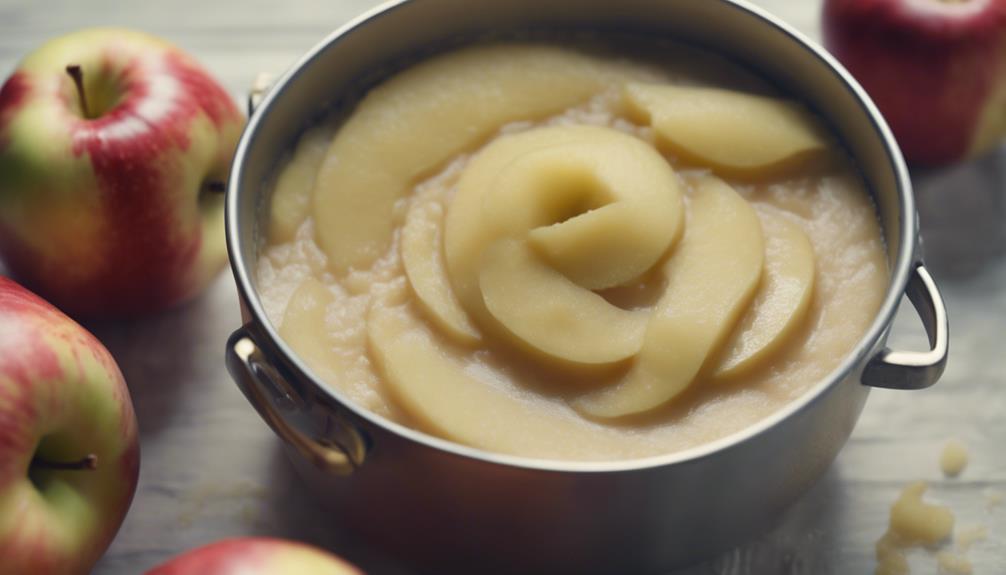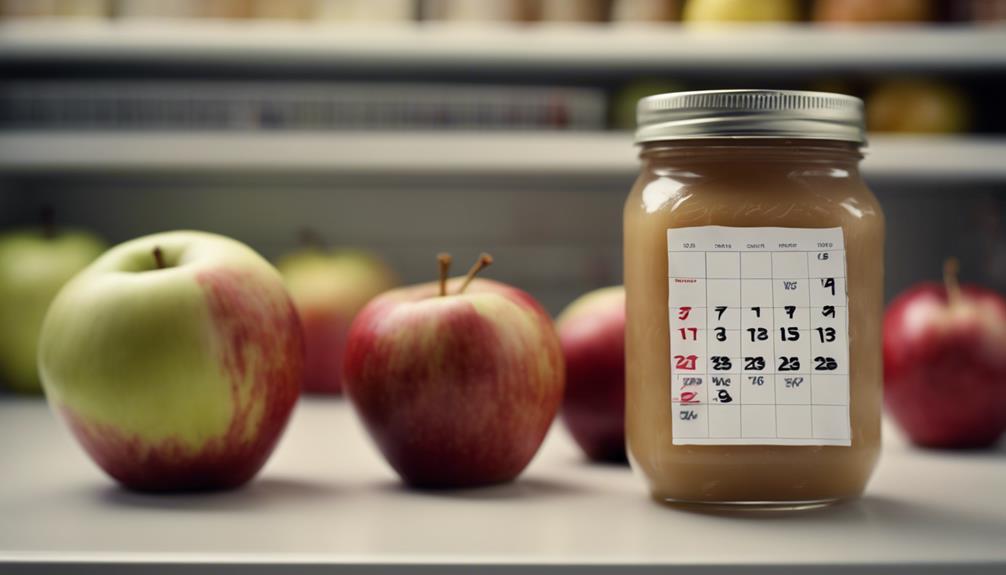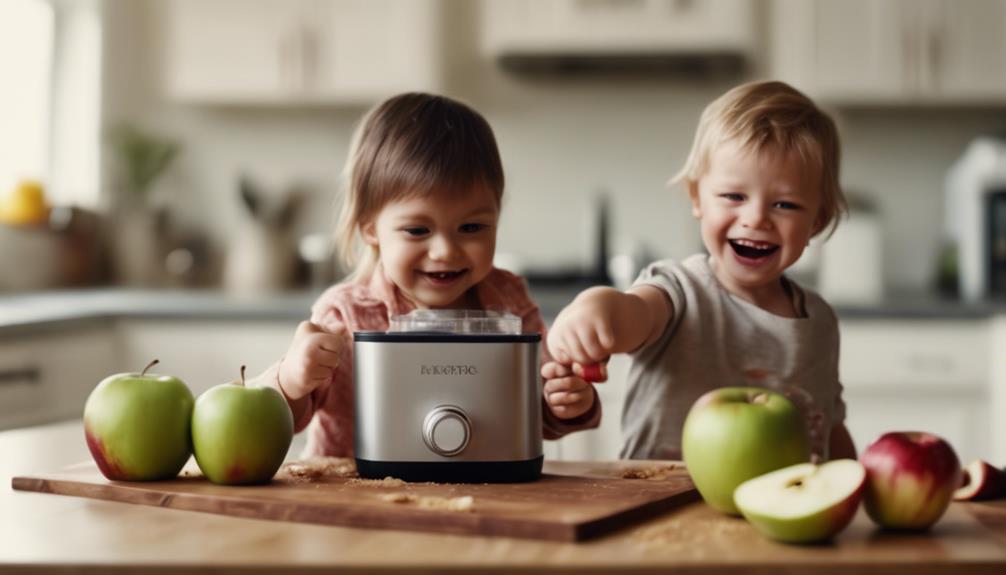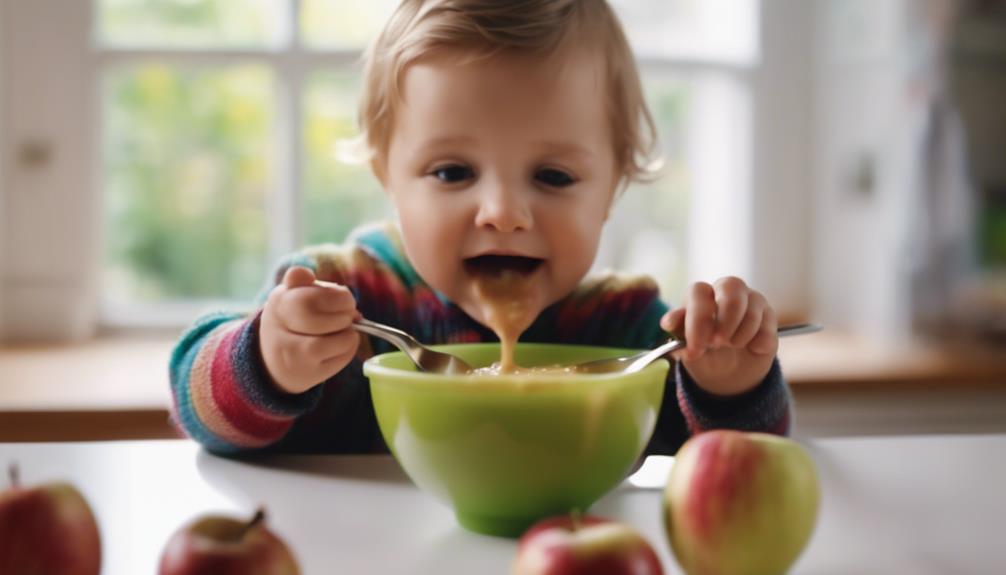Ready to create a delicious and nutritious applesauce that your little one will enjoy? Begin by gathering fresh apples, water, and a touch of cinnamon. Peel, core, and dice ripe apples, then cook with water until soft. Blend everything into a smooth puree. Explore different flavors like Cinnamon Swirl or Strawberry Fields to keep things interesting. Store in airtight containers in the refrigerator for two weeks, or freeze for up to a year. Enjoy chilled as a snack, or get inventive by using it as a topping or in baking. Interested in learning more about elevating your applesauce game?
Key Takeaways
- Choose sweet apples like Fuji or Gala for a toddler-friendly taste.
- Engage toddlers in the cooking process for a fun experience.
- Adjust sweetness levels with honey or sugar to suit preferences.
- Add subtle spices like cinnamon for enhanced flavor without overwhelming.
- Serve chilled as a healthy snack or topping for oatmeal and yogurt.
Ingredients for Homemade Applesauce
What ingredients do you need to make homemade applesauce for toddlers? Creating your own applesauce is a simple and nutritious way to provide a healthy snack for your little ones. For this easy homemade recipe, all you need are fresh apples, water, and a dash of cinnamon. By making your own applesauce, you have the advantage of controlling the amount of added sugars and preservatives, ensuring a wholesome treat for your toddlers.
Homemade applesauce is a versatile option that can be served on its own, mixed with yogurt, or even used as a topping for oatmeal. Not only is it a cost-effective choice, but it also eliminates any worries about unnecessary additives that store-bought versions may contain.
With just a few basic ingredients and minimal effort, you can whip up a batch of delicious homemade applesauce that your toddlers will love. So why not give it a try and see how easy and satisfying it can be to make this healthy snack at home?
Step-by-Step Instructions

Ready to whip up some delicious homemade applesauce for your little one?
Let's get started by following the simple step-by-step instructions.
You'll be creating a nutritious and toddler-friendly snack in no time!
Nutritious Toddler-Friendly Recipe
To create a nutritious homemade applesauce for toddlers, gather your ingredients and equipment. Start by selecting ripe apples, preferably a sweeter variety like Gala or Fuji. You'll also need water, cinnamon (optional), a saucepan, a knife, a cutting board, and a blender or food processor.
Wash the apples thoroughly, peel and core them, then chop them into small pieces. In a saucepan, combine the chopped apples with a little water and cinnamon for flavor if desired. Cook the apples on low heat until they're soft and tender.
Once the apples are cooked, let them cool slightly before blending them into a smooth puree. If the applesauce is too thick, you can add more water to reach your desired consistency.
Homemade applesauce is a fantastic way to provide essential nutrients and natural sweetness to your little one's diet. Plus, you can customize it to suit your toddler's taste preferences without worrying about added sugars or preservatives.
Simple Cooking Steps
Peel and core the apples before chopping them into bite-sized pieces for toddler-friendly applesauce.
Here's how to make Homemade Applesauce for your little ones:
- Prepare the Apples: Peel and core the apples, then chop them into small, toddler-friendly pieces.
- Cook the Apples: Place the chopped apples in a pot with water, sugar, and cinnamon to cook until tender.
- Adjust Cooking Time: Depending on your toddler's preference, cook the apples longer for a smoother texture or shorter for a chunkier applesauce.
- Engage Your Child: Involve your toddler in the process by letting them help with peeling, coring, and adding cinnamon for a fun cooking experience.
Healthy Mealtime Option
For a healthy mealtime option for your toddler, consider making homemade applesauce using fresh ingredients and minimal added sugars. Homemade applesauce is a nutritious choice that you can easily prepare at home for your little one.
Start by peeling, coring, and chopping fresh apples. Then, simmer the apples with water and a sprinkle of cinnamon if desired until they're soft and mashable. Blend or mash the cooked apples to your desired consistency—chunky or smooth—for your toddler to enjoy.
Homemade applesauce isn't only delicious but also allows you to control what goes into your child's snack, ensuring a preservative-free and healthy treat. Serve the applesauce as a standalone snack, a topping for oatmeal or yogurt, or incorporate it into baking recipes for a healthier twist.
Your toddler will love the different textures and flavors of this homemade delight. So, whip up a batch of this easy and nutritious applesauce recipe for a mealtime option that both you and your little one can feel good about.
Flavor Variations and Enhancements

Consider incorporating a variety of flavor enhancements, such as cinnamon, strawberry, peach, vanilla, or maple, to elevate the appeal of homemade applesauce for toddlers.
Here are some fun ways to enhance your applesauce:
- Cinnamon Swirl: Add a dash of cinnamon to your applesauce for a warm and cozy flavor that kids will love.
- Strawberry Fields: Mix in some fresh strawberries for a burst of fruity goodness in every bite.
- Peach Perfection: Incorporate diced peaches into your applesauce for a sweet and invigorating twist.
- Vanilla Dream: A hint of vanilla extract can add a subtle and enticing flavor to your homemade applesauce.
Storage and Shelf Life Tips

Let's chat about keeping your homemade applesauce fresh and tasty.
Storing it in the fridge can keep it delicious for up to 2 weeks, while freezing extends its shelf life for a whole year.
Make sure to use airtight containers like glass jars or reusable pouches for excellent preservation.
Proper Storage Recommendations
Store your homemade applesauce in airtight containers in the fridge or freezer to maintain freshness and extend its shelf life. Here are some tips to help you store your delicious applesauce properly:
- Choose the Right Containers: Opt for glass jars or WeeSprout Reusable Pouches as they're ideal for storing applesauce.
- Refrigeration: Store your applesauce in the fridge for up to 2 weeks to keep it fresh.
- Freezing: If you want to extend the shelf life, freeze your applesauce for up to 12 months.
- Thawing: When ready to enjoy your frozen applesauce, thaw it in the fridge to preserve its flavor and texture.
Extending Shelf Life
To guarantee your homemade applesauce stays fresh and delicious for an extended period, proper storage techniques play a key role in maintaining its quality.
When it comes to storing your homemade applesauce, the fridge is your best friend. Place it in airtight containers or glass jars to keep it fresh for up to 2 weeks.
If you want your applesauce to last even longer, freezing is the way to go. By freezing your homemade applesauce, you can extend its shelf life up to a whopping 12 months while preserving its flavor and quality. Remember to thaw the frozen applesauce in the fridge before serving to maintain its texture and taste.
For a convenient and eco-friendly storage option, consider using WeeSprout Reusable Pouches. These pouches not only help in storing your applesauce efficiently but also add a touch of sustainability to your kitchen practices.
Freezing for Preservation
Extend the shelf life of your homemade applesauce by freezing it for up to 12 months. To guarantee your delicious creation stays fresh and tasty, follow these tips:
- Choose the Right Containers: Opt for airtight containers to prevent freezer burn and maintain flavor.
- Label and Date: Don't forget to label your containers with the date of preparation to keep track of freshness.
- Thawing Technique: When ready to enjoy your frozen applesauce, thaw it in the fridge for the best texture and taste.
- WeeSprout Reusable Pouches: Consider using WeeSprout Reusable Pouches for freezing your homemade applesauce; they're convenient and practical.
Freezing your homemade applesauce is a fantastic way to preserve it for future use. By following these simple steps, you can enjoy your applesauce for up to a year while preserving its quality.
Tips for Successful Applesauce Making

For a smoother consistency, consider peeling the apples before cooking them for your toddler's applesauce. Sweet apple varieties like Fuji or Gala are ideal choices for a naturally sweet applesauce that your little one will love.
To cater to your toddler's taste preferences, you can easily adjust the sweetness levels by adding optional honey or sugar during the cooking process. It's important to make sure that the apples are cooked until soft and easily mashable to create a smooth texture suitable for toddlers.
If you prefer a smoother applesauce, peeling the apples before cooking is recommended, but leaving the peel on adds extra fiber to the dish.
Additionally, when adding spices, use cinnamon sparingly or opt for other mild spices to introduce subtle flavors without overwhelming your toddler's palate.
Serving Suggestions and Usage

Consider incorporating homemade applesauce into your toddler's daily meals for added nutrition and variety. Here are some serving suggestions to make the most out of this nutritious treat:
- Healthy Snack: Serve a small bowl of chilled applesauce as a nutritious snack option for your toddler during the day.
- Topping Delight: Use applesauce as a delicious topping for morning oatmeal, fluffy pancakes, or creamy yogurt to introduce new flavors and boost nutrition.
- Baking Swap: Replace oil or butter with applesauce in baking recipes for your toddlers to reduce fat content while keeping the treats moist and flavorful.
- Fruit Infusion: Experiment with adding fruits like strawberries or peaches to the applesauce to create exciting flavor combinations that will entice your toddler's taste buds.
Best Apples for Applesauce

To create flavorful and nutritious homemade applesauce for your toddler, start by selecting the best apples suited for this purpose, such as Golden Delicious, Fuji, Gravenstein, McIntosh, and Gala. Each of these apple varieties brings a unique flavor profile to your applesauce, allowing you to tailor it to your toddler's taste preferences. Here's a breakdown of these apples:
| Apple Variety | Flavor |
|---|---|
| Golden Delicious | Sweet |
| Fuji | Balanced |
| McIntosh | Tart |
| Gala | Mildly Sweet |
Golden Delicious apples are perfect for a sweeter applesauce, while McIntosh apples add a tangy kick. If you prefer a balanced flavor, Fuji apples are an excellent choice, and Gala apples offer a mildly sweet taste. Experimenting with different combinations of these apples can lead to a delightful and customized applesauce that your little one will love.
Recipe Modifications and Feedback

You revamped the recipe by reducing the number of apples, adding extra lemon juice, and setting some aside for garnishing. Here's a glimpse of how your modifications elevated the homemade applesauce for toddlers:
- The reduced number of apples intensified the flavors, creating a more concentrated and rich applesauce.
- The additional lemon juice brought a zesty kick to the recipe, balancing the sweetness of the apples perfectly.
- Setting some apples aside for garnishing added a visually appealing touch to the dish, making it even more enticing for little ones.
- The overall feedback from Wendy, Heather, Jenny, and Kristi has been overwhelmingly positive, with praises for the easy preparation, delicious taste, and versatility of this homemade treat.
With these modifications and the enthusiastic feedback received, it's clear that your homemade applesauce recipe is a hit among toddlers and adults alike. Keep up the fantastic work in the kitchen!
User Interaction and Engagement

Engagement from users like Wendy, Heather, Jenny, and Kristi on the homemade applesauce recipe page indicates its popularity and success among readers. Their comments not only provide valuable feedback on taste and ease of making the applesauce but also spark a lively interaction within the community.
Heather's creative modifications, such as adjusting the apple quantity, adding extra lemon juice, and using it as a topping, showcase the recipe's versatility and inspire others to experiment.
The user feedback, overflowing with positivity from Wendy, Heather, Jenny, and Kristi, serves as a confirmation to the deliciousness and broad appeal of this homemade applesauce recipe. Their interactions in the comments section, spanning back to February 2022, reveal an enduring interest in this simple yet nutritious recipe.
As users continue to engage, share their experiences, and suggest tweaks, the recipe's popularity only seems to be growing. So, why not join the conversation, share your thoughts, and perhaps even contribute your own unique twist to this beloved applesauce recipe?
Frequently Asked Questions
Is Applesauce Healthy for Toddlers?
Yes, applesauce is healthy for toddlers. It provides essential vitamins, fiber, and natural sweetness. Easy to digest and gentle on the stomach, it's a great snack option. Homemade allows control over ingredients, ensuring a healthier choice.
Is Homemade Applesauce Nutritious?
Homemade applesauce is indeed nutritious for toddlers. It offers essential vitamins and minerals without added sugars or preservatives. You can easily customize it to suit your child's taste preferences, ensuring a healthy and wholesome snack.
What Is the Healthiest Applesauce?
For the healthiest applesauce, opt for homemade with organic apples, keeping the peel for added nutrients. Choose no-preservative options without high fructose corn syrup. Control sweeteners for a nutritious choice. Vary apple types for different benefits.
What's the Difference Between Applesauce and Apple Puree?
When comparing applesauce and apple puree, note that applesauce is sweetened and spiced, offering a smoother texture, while apple puree is just blended apples without additional ingredients, providing a variety of textures.
Conclusion
To sum up, homemade applesauce is like a cozy hug in a bowl – warm, comforting, and full of love.
So grab those apples and get cooking, your little ones will thank you for it!
With just a few simple ingredients and easy steps, you can whip up a delicious and nutritious treat that will surely become a family favorite.
So go ahead, give it a try and enjoy the sweet taste of success!










